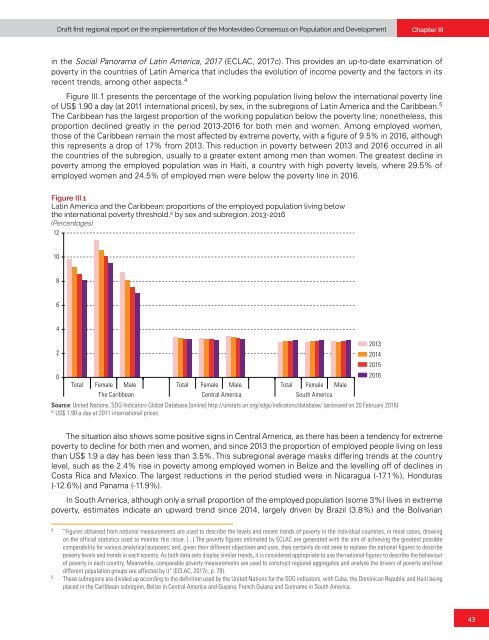Draft first regional report on the implementation of the Montevideo Consensus on Population and Development
This draft report seeks to give an account of progress in the implementation of the priority measures of the Montevideo Consensus on Population and Development in the region, as well as the differences between countries in terms of the degree of implementation. By highlighting relevant national experiences, it also seeks to facilitate the exchange of good practices among countries so that they can benefit from each other in their efforts to advance the implementation of the actions of the Montevideo Consensus.
This draft report seeks to give an account of progress in the implementation of the priority measures of the Montevideo Consensus on Population and Development in the region, as well as the differences between countries in terms of the degree of implementation. By highlighting relevant national experiences, it also seeks to facilitate the exchange of good practices among countries so that they can benefit from each other in their efforts to advance the implementation of the actions of the Montevideo Consensus.
Create successful ePaper yourself
Turn your PDF publications into a flip-book with our unique Google optimized e-Paper software.
<str<strong>on</strong>g>Draft</str<strong>on</strong>g> <str<strong>on</strong>g>first</str<strong>on</strong>g> <str<strong>on</strong>g>regi<strong>on</strong>al</str<strong>on</strong>g> <str<strong>on</strong>g>report</str<strong>on</strong>g> <strong>on</strong> <strong>the</strong> implementati<strong>on</strong> <strong>of</strong> <strong>the</strong> M<strong>on</strong>tevideo C<strong>on</strong>sensus <strong>on</strong> Populati<strong>on</strong> <strong>and</strong> <strong>Development</strong><br />
Chapter III<br />
in <strong>the</strong> Social Panorama <strong>of</strong> Latin America, 2017 (ECLAC, 2017c). This provides an up-to-date examinati<strong>on</strong> <strong>of</strong><br />
poverty in <strong>the</strong> countries <strong>of</strong> Latin America that includes <strong>the</strong> evoluti<strong>on</strong> <strong>of</strong> income poverty <strong>and</strong> <strong>the</strong> factors in its<br />
recent trends, am<strong>on</strong>g o<strong>the</strong>r aspects. 4<br />
Figure III.1 presents <strong>the</strong> percentage <strong>of</strong> <strong>the</strong> working populati<strong>on</strong> living below <strong>the</strong> internati<strong>on</strong>al poverty line<br />
<strong>of</strong> US$ 1.90 a day (at 2011 internati<strong>on</strong>al prices), by sex, in <strong>the</strong> subregi<strong>on</strong>s <strong>of</strong> Latin America <strong>and</strong> <strong>the</strong> Caribbean. 5<br />
The Caribbean has <strong>the</strong> largest proporti<strong>on</strong> <strong>of</strong> <strong>the</strong> working populati<strong>on</strong> below <strong>the</strong> poverty line; n<strong>on</strong>e<strong>the</strong>less, this<br />
proporti<strong>on</strong> declined greatly in <strong>the</strong> period 2013-2016 for both men <strong>and</strong> women. Am<strong>on</strong>g employed women,<br />
those <strong>of</strong> <strong>the</strong> Caribbean remain <strong>the</strong> most affected by extreme poverty, with a figure <strong>of</strong> 9.5% in 2016, although<br />
this represents a drop <strong>of</strong> 17% from 2013. This reducti<strong>on</strong> in poverty between 2013 <strong>and</strong> 2016 occurred in all<br />
<strong>the</strong> countries <strong>of</strong> <strong>the</strong> subregi<strong>on</strong>, usually to a greater extent am<strong>on</strong>g men than women. The greatest decline in<br />
poverty am<strong>on</strong>g <strong>the</strong> employed populati<strong>on</strong> was in Haiti, a country with high poverty levels, where 29.5% <strong>of</strong><br />
employed women <strong>and</strong> 24.5% <strong>of</strong> employed men were below <strong>the</strong> poverty line in 2016.<br />
Figure III.1<br />
Latin America <strong>and</strong> <strong>the</strong> Caribbean: proporti<strong>on</strong>s <strong>of</strong> <strong>the</strong> employed populati<strong>on</strong> living below<br />
<strong>the</strong> internati<strong>on</strong>al poverty threshold, a by sex <strong>and</strong> subregi<strong>on</strong>, 2013-2016<br />
(Percentages)<br />
12<br />
10<br />
8<br />
6<br />
4<br />
2<br />
0<br />
Total Female Male Total Female Male Total Female Male<br />
The Caribbean Central America South America<br />
Source: United Nati<strong>on</strong>s, SDG Indicators Global Database [<strong>on</strong>line] http://unstats.un.org/sdgs/indicators/database/ (accessed <strong>on</strong> 20 February 2018).<br />
a<br />
US$ 1.90 a day at 2011 internati<strong>on</strong>al prices.<br />
2013<br />
2014<br />
2015<br />
2016<br />
The situati<strong>on</strong> also shows some positive signs in Central America, as <strong>the</strong>re has been a tendency for extreme<br />
poverty to decline for both men <strong>and</strong> women, <strong>and</strong> since 2013 <strong>the</strong> proporti<strong>on</strong> <strong>of</strong> employed people living <strong>on</strong> less<br />
than US$ 1.9 a day has been less than 3.5%. This sub<str<strong>on</strong>g>regi<strong>on</strong>al</str<strong>on</strong>g> average masks differing trends at <strong>the</strong> country<br />
level, such as <strong>the</strong> 2.4% rise in poverty am<strong>on</strong>g employed women in Belize <strong>and</strong> <strong>the</strong> levelling <strong>of</strong>f <strong>of</strong> declines in<br />
Costa Rica <strong>and</strong> Mexico. The largest reducti<strong>on</strong>s in <strong>the</strong> period studied were in Nicaragua (-17.1%), H<strong>on</strong>duras<br />
(-12.6%) <strong>and</strong> Panama (-11.9%).<br />
In South America, although <strong>on</strong>ly a small proporti<strong>on</strong> <strong>of</strong> <strong>the</strong> employed populati<strong>on</strong> (some 3%) lives in extreme<br />
poverty, estimates indicate an upward trend since 2014, largely driven by Brazil (3.8%) <strong>and</strong> <strong>the</strong> Bolivarian<br />
4<br />
“Figures obtained from nati<strong>on</strong>al measurements are used to describe <strong>the</strong> levels <strong>and</strong> recent trends <strong>of</strong> poverty in <strong>the</strong> individual countries, in most cases, drawing<br />
<strong>on</strong> <strong>the</strong> <strong>of</strong>ficial statistics used to m<strong>on</strong>itor this issue. (...) The poverty figures estimated by ECLAC are generated with <strong>the</strong> aim <strong>of</strong> achieving <strong>the</strong> greatest possible<br />
comparability for various analytical purposes; <strong>and</strong>, given <strong>the</strong>ir different objectives <strong>and</strong> uses, <strong>the</strong>y certainly do not seek to replace <strong>the</strong> nati<strong>on</strong>al figures to describe<br />
poverty levels <strong>and</strong> trends in each country. As both data sets display similar trends, it is c<strong>on</strong>sidered appropriate to use <strong>the</strong> nati<strong>on</strong>al figures to describe <strong>the</strong> behaviour<br />
<strong>of</strong> poverty in each country. Meanwhile, comparable poverty measurements are used to c<strong>on</strong>struct <str<strong>on</strong>g>regi<strong>on</strong>al</str<strong>on</strong>g> aggregates <strong>and</strong> analyse <strong>the</strong> drivers <strong>of</strong> poverty <strong>and</strong> how<br />
different populati<strong>on</strong> groups are affected by it” (ECLAC, 2017c, p. 79).<br />
5<br />
These subregi<strong>on</strong>s are divided up according to <strong>the</strong> definiti<strong>on</strong> used by <strong>the</strong> United Nati<strong>on</strong>s for <strong>the</strong> SDG indicators, with Cuba, <strong>the</strong> Dominican Republic <strong>and</strong> Haiti being<br />
placed in <strong>the</strong> Caribbean subregi<strong>on</strong>, Belize in Central America <strong>and</strong> Guyana, French Guiana <strong>and</strong> Suriname in South America.<br />
43


















